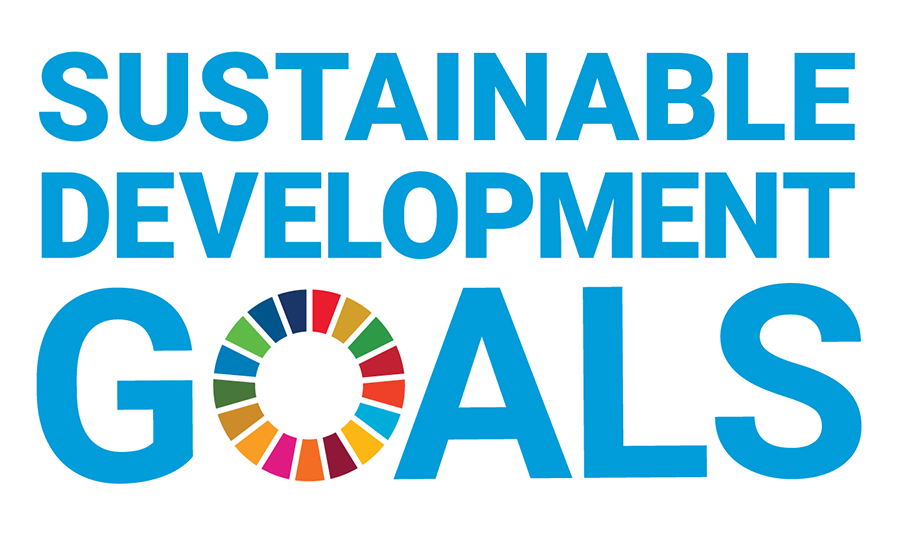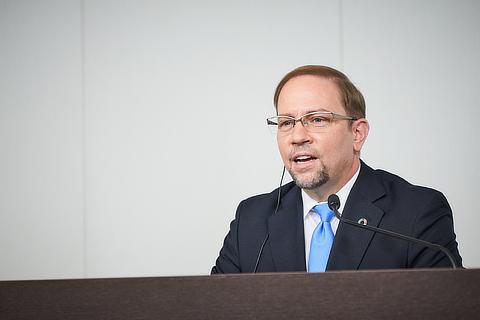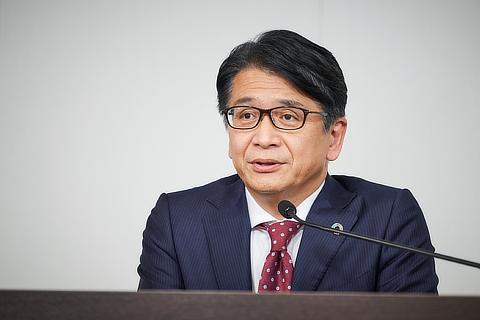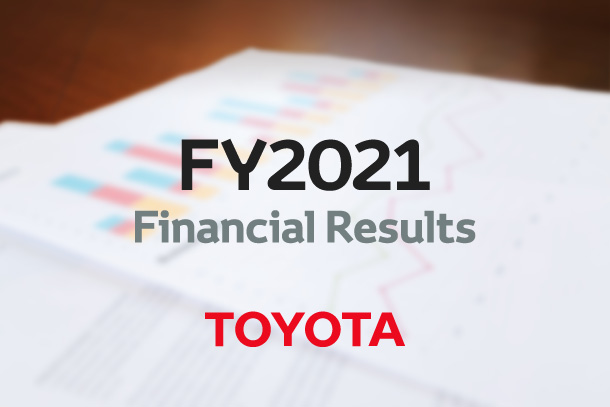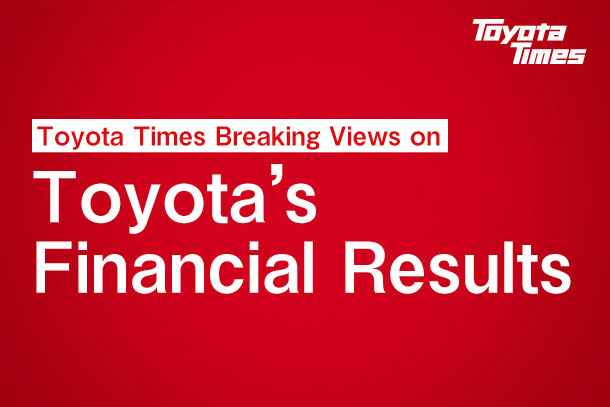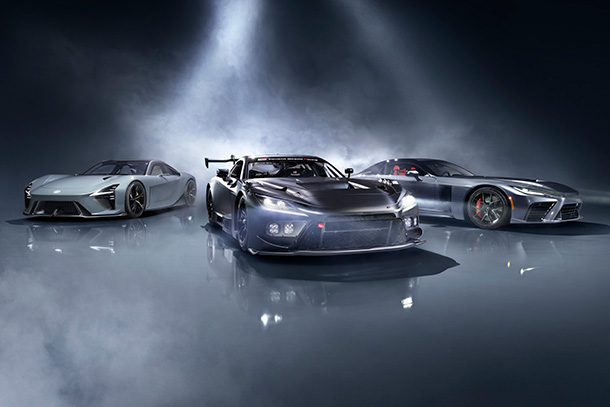Toyota City, Japan, May 12, 2021―Toyota Motor Corporation (TMC) announced its financial results for the fiscal year ended March 31, 2021 today. Video of the press briefing is available below.
- TMC's Year-end Financial Results Press Briefing -Session 1-
- Explanation of financial results and Q&A
Toyota Attendees
- TMC's Year-end Financial Results Press Briefing -Session 2-
- Explanation of the company's efforts and Q&A
Remarks from James Kuffner "TOYOTA'S STRATEGY and COMMITMENT to CARBON NEUTRALITY"
- Introduction
Good afternoon.
Today, I am excited to share with you a glimpse of Toyota's technology and strategy with regards to Carbon Neutrality.
Before I begin, I would like to express deep gratitude to the millions of Toyota customers who continue to choose our products and services and place their trust in us.
The COVID-19 global pandemic has been difficult for everyone.
These strong financial results that we have shared today were only possible due to the hard work and dedication of Toyota group employees, suppliers, dealers, and partners worldwide.
Thanks to these amazing people, Toyota can continue to create and develop advanced technologies and provide outstanding products and services that fulfill the needs of customers all over the world.
- "Carbon Neutrality"
"The Toyota Philosophy" was developed to guide our company. At its foundation is Mobility and Happiness for all.
For over 80 years, Toyota has been executing on its vision and mission to mass produce happiness, and deliver safe, sustainable, mobility technology to customers globally.
As part of that mission, Toyota has been working hard to help all countries and regions around the world achieve carbon neutrality through its products.
In addition, Toyota is 100% committed as a company to achieving carbon neutrality by 2050 or earlier.
What does Carbon Neutrality actually mean for the automotive industry?
Carbon neutrality for the automotive industry means achieving zero CO2 emissions in all processes throughout the lifecycle of "manufacturing", "transporting", "operating", "fueling and/or charging", and "recycling and disposing of" vehicles.
Toyota's History of Innovation, Accomplishments, and Progress Towards CN
Toyota has been innovating and investing in technology to reduce emissions and achieve carbon neutrality for over 30 years.
In the early 1990s, Toyota committed to achieving the ambitious goal of building a practical mass-market vehicle that would have twice the fuel efficiency of a Corolla class vehicle with the same high reliability and low-cost that Toyota customers expect.
There were many skeptics at the time.
In 1996, Toyota developed and launched its first battery electric vehicle, the RAV4 EV.
The RAV4 EV faced significant challenges related to limited range, long charging times, and lack of available charging infrastructure.
But Toyota engineers used customer feedback and valuable knowledge from the RAV4 EV development to improve both battery technology and power electronics.
In 1997, Toyota launched the best-selling Prius, the world's first mass-produced hybrid electric vehicle.
Bringing practical HEVs to market was not easy.
It involved many innovations in motors, inverters, engines, batteries, and electronics.
Some of Toyota's innovations in battery technology included materials, manufacturing processes, improved safety and crash-worthiness, high-power output performance, and better recyclability for sustainable manufacturing.
Building upon that experience, over the past 25 years, Toyota has remained committed to developing an array of new technologies and products to help reduce carbon emissions.
We have successfully developed and launched a wide variety of innovative products including hybrid electric vehicles, battery electric vehicles, plug-in hybrid electric vehicles, and hydrogen fuel cell electric vehicles.
Toyota's World-leading Electrified Vehicle Technology
The success of the Prius demonstrated that our commitment to carbon neutrality had also created a once-in-a-generation opportunity for innovation and market leadership.
Today, Toyota offers the world's largest lineup of 55 practical, reliable, and affordable electrified vehicles all over the world, with many more to come.
Our combined sales volume of electrified vehicles, including HEVs, BEVs, PHEVs, and FCEVs is now more than 2 million vehicles per year.
The Atkinson cycle engines in our HEVs and PHEVs are extraordinarily efficient - up to around 40%.
These efficiency improvements have helped reduce emissions in many parts of the world, particularly those with less green power infrastructure.
The net positive impact of Toyota's innovations enabled an estimated reduction in total cumulative carbon emissions of approximately 140 million tons in over 20 years.
This is equivalent to removing 1.5 million typical passenger vehicles from our world's roads every year over that time period.
We are proud of these achievements, but we know we can and we MUST do better.
That is why we are rapidly introducing 15 battery electric vehicle models globally by 2025, including seven recently announced TOYOTA bZ models.
We are also expanding and improving our product lineup of HEVs, PHEVs, and FCEVs.
To support all of these new products, Toyota will continue to make global investments in exciting new battery technology, such as solid state batteries.
Along with more efficient electric motors, these new batteries will help make EVs more practical, safer, and more sustainable.
Toyota's Strategy, Ongoing Investments, and Commitment To Achieving CN
Toyota believes the world can achieve Carbon Neutrality, but there are still many challenges to realizing our dream.
Even with perfect battery technology, a BEV will still generate tons of CO2 emissions over its lifetime if it is charged by electricity produced by coal or other non-renewable energy sources.
Another challenge is that not everyone has convenient access to charging infrastructure.
I am one of them: I live in an apartment building in Tokyo, and have no ability to plug in a vehicle.
Fortunately, Toyota can offer me additional choices.
For example, PHEVs offer flexibility and can be built with smaller batteries using fewer materials. PHEVs can be driven in zero-emissions electric mode, optimized for the short trips that make up most of the world's driving, as well as providing a hybrid mode for longer trips.
Hydrogen Fuel Cell Alternatives
In addition, Toyota continues to aggressively invest in complimentary new green energy technologies aimed at achieving carbon neutrality.
Toyota is the world leader in Hydrogen Fuel Cell technology.
Hydrogen is the most abundant element in the universe and can be produced locally at the point of use with nothing but renewable energy and water.
Hydrogen can also provide long-term storage of renewable energy for use during peak times.
After more than 20 years of research and development, in 2014, Toyota Launched the Mirai, our first mass-produced hydrogen fuel cell electric vehicle, which won the World Green Car of the Year Award in 2016.
Fuel cell technology is truly magical.
As the vehicle moves, air from the outside combines with Hydrogen in the fuel cell to produce electricity and water.
A pure and simple zero emissions vehicle that can be refueled in three minutes.
Our second generation Mirai was announced last December.
We improved performance, comfort, and efficiency, increasing EPA range to 647 km (402 mi).
Despite these improvements, hydrogen energy still faces many challenges related to available infrastructure, overall efficiency, and enabling low-cost clean hydrogen production.
Toyota will continue to invest in technology to overcome these challenges.
Moreover, passenger cars are only a small part of Hydrogen's future potential.
Toyota's hydrogen fuel cell technology could help to clean up a large percentage of the world's entire transportation ecosystem.
That means achieving carbon neutrality in trucks and heavy transport, trains, buses, taxis, aviation, shipping, forklifts, and industrial processes, all of whose combined CO2 emissions exceed those of passenger cars.
Toyota has also developed modular fuel cells and a "standalone" fuel cell generator that can be repositioned to produce electricity anywhere, on demand.
For example, you can use Toyota's standalone fuel cell generator to quickly deploy a charging station for a BEV or PHEV.
Cleaning up ICE vehicles
But cleaning up "new vehicle" sales is just the beginning.
There are more than 1.4 billion vehicles in the world today, and most of them have internal combustion engines.
Toyota is exploring possible ways to clean up the world's legacy fleet of ICE vehicles that will still be in operation during the next 10-15 years.
Hydrogen fuel can also be burned as a cleaner fuel.
Just last month, Toyota demonstrated a new hydrogen engine prototype that could expand the options for achieving carbon neutrality faster.
In the world of motorsports, where the development speed of new technology is rapid, President Toyoda, who is a master driver himself, takes the wheel and repeatedly evaluates these vehicles and technology progress.
Toyota's work in "making ever better cars" now also has the potential to enable more environmentally-friendly motorsports.
Commitment to Achieving Carbon Neutrality
In everything that we do, Toyota is and has always been firmly committed to Carbon Neutrality.
Toyota has the world's largest and rapidly expanding lineup of electrified vehicles, consisting of BEVs, HEVs, PHEVs, and FCEVs.
Because of our unique history of working with electrification for nearly 25 years, Toyota's technology is world-class and strongly positioned to help different countries around the world reduce emissions and achieve Carbon Neutrality faster.
This was all done before mandated rules by governments or the recent global movement and growing awareness of the need for Carbon Neutrality.
Giving back to the world, and having a clean future, is in our Toyota DNA.
Conclusion
We are very excited about the future of electrified mobility, and the tremendous new products and business opportunities that the green economy will create as we make progress towards achieving our goal of Carbon Neutrality.
However, no single company, including Toyota, can accomplish this goal alone.
All industries must work together to develop new technology and infrastructure in cooperation with scientists and academia, as well as local and national governments.
This is a challenge that we are excited about facing, because it will not only lead to better products, but also help protect our precious planet at the same time.
We would like to be a trusted partner to build the best products suitable for people in every part of the world to achieve carbon neutrality faster, with Toyota's brand representing quality, reliability, low-cost, and long-lasting value.
Toyota is 100% committed to the global goal of achieving carbon neutrality by 2050 and as a result, a brighter, happier future for us all.
Thank you.
Toyota Motor Corporation works to develop and manufacture innovative, safe and high-quality products and services that create happiness by providing mobility for all. We believe that true achievement comes from supporting our customers, partners, employees, and the communities in which we operate. Since our founding over 80 years ago in 1937, we have applied our Guiding Principles in pursuit of a safer, greener and more inclusive society. Today, as we transform into a mobility company developing connected, automated, shared and electrified technologies, we also remain true to our Guiding Principles and many of the United Nations' Sustainable Development Goals to help realize an ever-better world, where everyone is free to move.
- SDGs Initiatives
- https://global.toyota/en/sustainability/sdgs/
